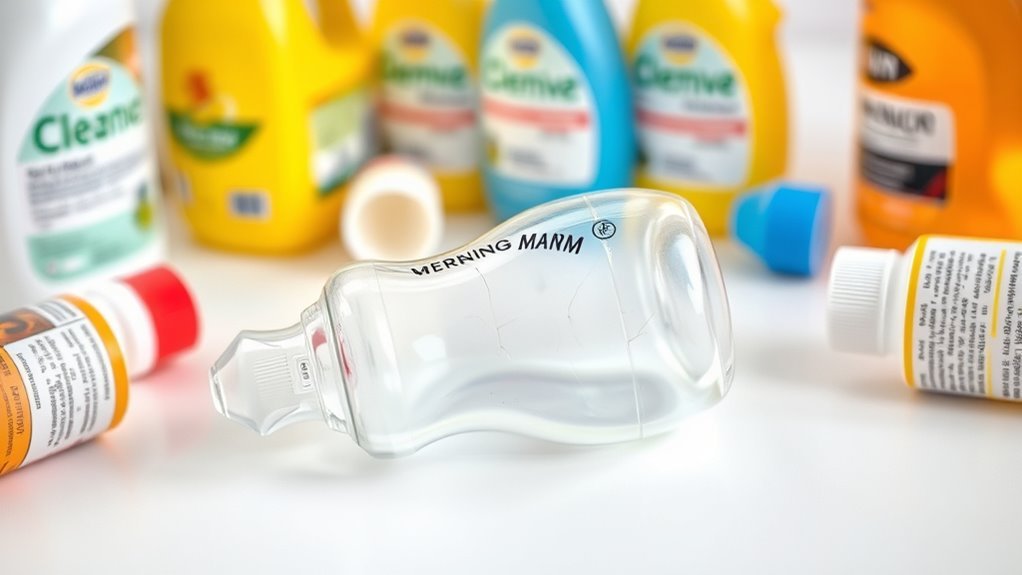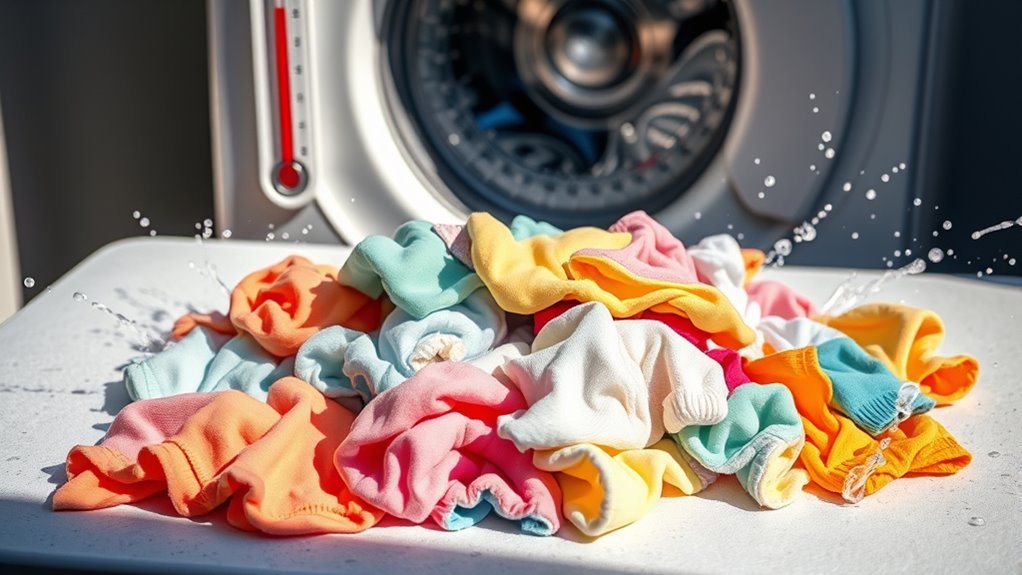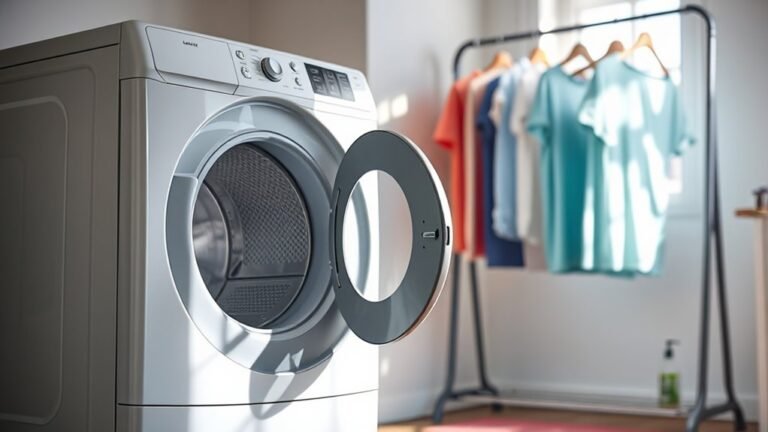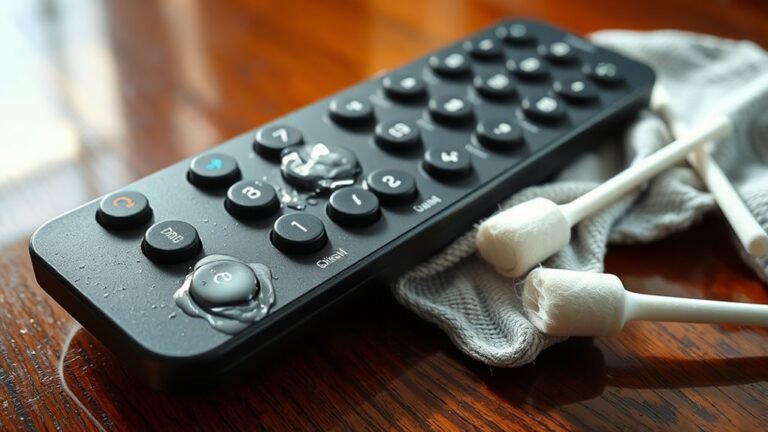Cleaning Mistakes That Damage Your Baby Items
You might be harming your baby’s items without realizing it by using harsh chemicals on bottles or skipping a thorough rinse, leaving residues that irritate delicate skin. Washing clothes in hot water can shrink them, while drying items in direct sunlight may cause fading and damage. Ignoring manufacturer instructions and overloading the dishwasher also reduces cleaning effectiveness. Storing damp items invites mold, and skipping regular pacifier cleaning risks germs. Keep this up, and your baby gear’s safety and longevity suffer—there’s more you should know to protect your little one.
Using Harsh Chemicals on Baby Bottles

When it comes to cleaning baby bottles, using harsh chemicals might seem like a quick solution, but it can actually do more harm than good. You want to guarantee your baby’s health, so relying on gentle, effective bottle sterilization methods is key. Harsh chemicals can leave behind residues that are tough to rinse away, leading to chemical residue concerns that might affect your baby’s delicate system. Instead, consider safer options like steam sterilizers or boiling water, which eliminate bacteria without introducing harmful substances. These methods give you the freedom to clean confidently without risking irritation or exposure to toxins. Choosing the right sterilization approach means protecting your baby while keeping your cleaning routine simple, safe, and free from unnecessary chemicals.
Neglecting to Rinse Cleaning Agents Thoroughly
While choosing gentle cleaning methods is important, it’s equally essential to make sure you rinse all cleaning agents off baby items thoroughly. Neglecting proper rinsing techniques can leave harmful residue effects that irritate your baby’s sensitive skin or cause ingestion risks.
To avoid this, you should:
To avoid residue, rinse baby items thoroughly, focusing on crevices, and allow them to air dry completely.
- Rinse items under running water for at least 30 seconds
- Use a clean brush or cloth to remove trapped soap
- Pay special attention to crevices and nipples
- Avoid soaking in soapy water without thorough rinsing afterward
- Let items air dry completely to prevent bacteria growth
Washing Baby Clothes in Hot Water

You might think washing baby clothes in hot water guarantees cleanliness, but it can actually cause fabric shrinking and color fading. These changes not only affect the clothes’ fit but also their appearance. Understanding the right water temperature helps protect your baby’s wardrobe while keeping it fresh and safe.
Fabric Shrinking Risks
Although hot water can seem like a quick way to sanitize baby clothes, it often leads to fabric shrinking that ruins their fit and comfort. When you want to maintain ideal fabric care, it’s essential to be mindful of washing temperatures. High heat can cause fibers to contract, leaving clothes smaller and stiffer than before. To avoid this, consider these tips:
- Always check garment labels for recommended washing temperatures
- Use cold or warm water cycles for delicate baby fabrics
- Avoid high-heat drying; opt for air drying or low heat settings
- Separate cottons and synthetics to prevent uneven shrinkage
- Don’t overload your washer, as it stresses fabrics during agitation
Color Fading Issues
Hot water doesn’t just shrink baby clothes—it can also cause colors to fade quickly, dulling those bright, cheerful fabrics you want to keep vibrant. When you wash baby clothes in hot water, it breaks down dyes, reducing fabric colorfastness and making colors bleed or fade prematurely. To protect your baby’s wardrobe, focus on color fading prevention by using cold or lukewarm water and gentle detergents formulated for delicate fabrics. Avoid harsh chemicals and over-drying, which also accelerate fading. By washing with care, you maintain the lively look of your baby’s clothes without sacrificing cleanliness. You deserve the freedom to keep your baby’s items fresh and beautiful—so choose methods that preserve fabric colorfastness and extend the life of those precious garments.
Ignoring Manufacturer’s Cleaning Instructions
You might think skipping the label’s cleaning instructions saves time, but it can actually harm your baby’s items or reduce their lifespan. Those guidelines are there to protect delicate fabrics and materials from damage or shrinking. By following them, you guarantee safety and keep your baby’s belongings in the best condition possible.
Importance of Label Guidelines
When you overlook the manufacturer’s cleaning instructions on baby items, you risk damaging the product or compromising your child’s safety. Understanding the label importance is key to preserving your baby’s items and guaranteeing their well-being. Guideline adherence isn’t just a suggestion—it’s essential for maintaining quality and safety. By following label guidelines, you:
- Protect delicate materials from harsh chemicals or improper washing
- Maintain the item’s structural integrity, preventing wear and tear
- Avoid allergic reactions from residue or inappropriate cleaning agents
- Guarantee longevity, saving you money and hassle over time
- Keep your baby’s environment hygienic without unnecessary risks
Respecting these instructions empowers you to clean confidently and responsibly. Remember, labels are there to guide your freedom in care, not restrict it.
Risks of Ignoring Instructions
Although it might seem harmless to skip or modify cleaning instructions, ignoring the manufacturer’s guidelines can lead to significant risks for both your baby’s health and the longevity of the items. The risks associated with not following guidelines include damaging delicate materials, reducing the effectiveness of sanitization, and even causing harmful chemicals to linger. When you disregard these instructions, you could unintentionally create a breeding ground for bacteria or weaken safety features designed to protect your child. Following guidelines isn’t about limiting your freedom—it’s about ensuring your baby’s items remain safe, clean, and durable. By respecting manufacturer recommendations, you’re making a smart choice that benefits your child’s well-being and extends the life of those important items you rely on every day.
Drying Baby Items in Direct Sunlight

Since direct sunlight can seem like an easy way to dry baby items quickly, you might not realize it could cause damage. Prolonged sunlight exposure can lead to UV damage, weakening fabrics and plastics. This makes your baby’s belongings less safe and less durable. To protect your items, avoid drying them in direct sun because:
- UV rays can fade colors and patterns
- Fabrics may become brittle and tear easily
- Plastic toys risk cracking or warping
- Elastic components lose stretch and shape
- Residual moisture might linger inside thick materials
Instead, dry baby items in a shaded, well-ventilated area. This approach preserves their quality while keeping your baby’s essentials safe and fresh. You deserve freedom from worry, so handle drying with care to maintain your baby’s items’ longevity.
Using Abrasive Scrubbers on Toys
Taking care to dry baby items properly is just one part of keeping them in good condition. Using abrasive scrubbers on toys can wear down surfaces, especially given the delicate toy material types like soft plastics and painted wood. You want to avoid scratches that harbor bacteria or cause toxins to leach. Instead, opt for safe cleaning alternatives like soft cloths or gentle brushes.
| Toy Material Types | Safe Cleaning Alternatives |
|---|---|
| Soft Plastics | Microfiber cloth, mild soap |
| Painted Wood | Soft sponge, diluted vinegar |
| Silicone | Soft brush, warm soapy water |
Storing Damp Items Without Proper Drying
You might not realize that storing baby items while they’re still damp can quickly lead to mold growth, which poses health risks for your little one. It’s essential to guarantee everything is completely dry before putting them away to keep germs at bay. Simple drying techniques, like air drying in a well-ventilated area, can make all the difference in maintaining a safe environment.
Risks of Mold Growth
Although it might seem harmless to set baby bottles or toys aside while they’re still damp, doing so can quickly lead to mold growth. Mold thrives in moist environments, and without proper mold prevention and humidity control, your baby’s items become breeding grounds for harmful spores. This not only damages the items but also poses health risks to your little one.
Here’s what you risk by storing damp baby items:
- Allergic reactions and respiratory issues for your baby
- Unpleasant odors that linger
- Damage and deterioration of plastic and fabric
- Hidden mold colonies that are hard to spot
- Compromised hygiene despite cleaning efforts
To keep your baby’s belongings safe and clean, controlling moisture is essential. Don’t let dampness rob you of peace of mind or your baby’s health.
Proper Drying Techniques
When baby items aren’t dried properly before storing, moisture gets trapped and creates the perfect environment for bacteria and mold to grow. To protect your little one’s health and maintain item longevity, you need to prioritize proper drying techniques. Air drying methods are your best friend here—simply place cleaned items in a well-ventilated space where air can circulate freely. Avoid stuffing damp bottles, toys, or clothes into drawers or containers, as this traps moisture and invites mold. Proper ventilation is critical; using a drying rack near a window or fan guarantees quick, thorough drying. By mastering these steps, you reduce contamination risks and give your baby’s belongings the clean, safe environment they deserve. It’s a simple habit that grants you peace of mind and freedom from constant worry.
Overloading the Dishwasher With Baby Gear
Because baby items are often small and numerous, it’s tempting to cram them all into the dishwasher at once. However, overloading the dishwasher can reduce cleaning efficiency and damage delicate baby gear. Respect your dishwasher capacity to guarantee each item gets properly cleaned and dried. Thoughtful baby gear placement is essential—avoid stacking bottles or placing small parts where they can block spray arms. To protect your baby’s items:
- Don’t exceed dishwasher capacity; wash in batches if needed.
- Place bottles and nipples securely to avoid warping.
- Separate small pieces to prevent them from falling through racks.
- Avoid crowding to allow proper water circulation.
- Use a gentle cycle designed for delicate items.
Skipping Regular Cleaning of Pacifiers and Teething Toys
If you skip regular cleaning of pacifiers and teething toys, harmful bacteria and germs can quickly build up, putting your baby’s health at risk. Maintaining proper pacifier hygiene and teething toy maintenance isn’t just about cleanliness—it’s about safeguarding your little one’s freedom to explore safely. Neglecting these items can lead to infections and discomfort.
| Item | Cleaning Frequency | Recommended Method |
|---|---|---|
| Pacifiers | Daily | Boil or use sterilizer |
| Teething Toys | After each use | Wash with warm soapy water |
| Silicone Toys | Weekly | Dishwasher safe |
| Plastic Toys | Weekly | Soap and water |
| Rubber Toys | Twice a week | Vinegar solution rinse |
Stay consistent to protect your baby and enjoy peace of mind.
Using Fabric Softeners on Baby Clothes
Why should you think twice before using fabric softeners on your baby’s clothes? Fabric softeners often contain chemicals that can irritate delicate baby skin sensitivities, leading to rashes or allergic reactions. Plus, they can reduce the fabric’s absorbency, making clothes less breathable and comfortable for your little one.
Consider these points before reaching for that bottle:
- Chemicals in softeners may trigger skin irritation
- Residue buildup can affect fabric breathability
- Softener scents might overwhelm sensitive noses
- They can diminish the effectiveness of flame-retardant fabrics
- Fabric softener alternatives, like white vinegar or baking soda, clean gently without harsh additives
Choosing safer options helps keep your baby’s clothes fresh, soft, and safe—giving you peace of mind and your baby freedom to move comfortably.
Häufig gestellte Fragen
How Often Should I Deep Clean My Baby’s Feeding Bottles?
You should deep clean your baby’s feeding bottles at least once a day to keep them safe and hygienic. While regular rinsing after each use is essential, a thorough bottle cleaning helps remove stubborn milk residue and bacteria. Align this with your feeding schedule to avoid buildup. Deep cleaning guarantees your baby’s health without adding stress, giving you freedom to focus on bonding and enjoying feeding times confidently.
What Natural Alternatives Can I Use Instead of Harsh Chemicals?
You can switch to natural alternatives like a vinegar solution and baking soda to clean your baby’s items safely. Vinegar solution works great as a gentle disinfectant, while baking soda helps scrub away residue without harsh chemicals. These options are effective, non-toxic, and free you from worrying about harmful residues. Using them gives you peace of mind, keeping your baby’s items clean and safe without compromising your natural lifestyle.
Can Using a Sterilizer Replace Regular Washing of Baby Items?
Can a sterilizer truly replace regular washing of baby items? While sterilizer effectiveness is impressive in killing germs, it doesn’t remove dirt or milk residue. So, you shouldn’t skip washing altogether. Think of sterilizing as an extra step, not a substitute. Maintaining washing frequency guarantees items are clean before sterilization, giving your baby the safest environment. You deserve the freedom to trust both methods working together for your little one’s health.
How Do I Remove Stubborn Stains From Baby Clothes Safely?
When tackling stubborn stains on baby clothes, you want to focus on gentle stain removal methods that respect fabric care. Start by soaking the garment in cold water with a baby-safe detergent, then gently rub the stain. Avoid harsh chemicals or bleach, which can damage delicate fabrics. If needed, use a natural stain remover like baking soda or white vinegar. Patience and care guarantee your baby’s clothes stay fresh without compromising their softness or safety.
Are There Any Baby Items That Should Never Go in the Dishwasher?
Did you know that over 70% of parents use dishwashers to clean baby gear? While it’s convenient, not all baby items are dishwasher safe. Bottles with silicone nipples, wooden toys, and items with electronic parts should never go in the dishwasher. To protect your baby’s items and guarantee dishwasher safety, always check manufacturer guidelines. This way, you keep your baby gear clean without risking damage, giving you peace of mind and freedom.






